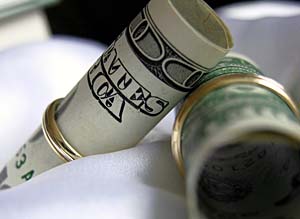Diamonds: you’ve been had, suckers
 Ah, diamonds. The ultimate symbol of an eternal commitment between two people in love, right? In fact, here in America, this sentiment is so strong that a diamond ring is viewed as an absolutely essential component of a marriage engagement proposal by virtually everyone. And of course, the more expensive the diamond, the more impressive the display of love—there are even helpful guidelines in place to let men know the minimum acceptable amount to spend when shopping for an engagement ring (two months’ salary, guys).
Ah, diamonds. The ultimate symbol of an eternal commitment between two people in love, right? In fact, here in America, this sentiment is so strong that a diamond ring is viewed as an absolutely essential component of a marriage engagement proposal by virtually everyone. And of course, the more expensive the diamond, the more impressive the display of love—there are even helpful guidelines in place to let men know the minimum acceptable amount to spend when shopping for an engagement ring (two months’ salary, guys).
But did you ever stop to think about how diamonds got elevated to this lofty status? Or why nearly every American couple chooses to express their commitment in exactly the same way (by spending several thousand dollars on a rock, of all things)?
The answer is that most Americans behave this way because they were told to. The genius marketing minds at N.W. Ayers & Son created the diamond market essentially out of thin air way back in the 1930s with an advertising campaign that taught us that diamonds = love, and Americans have been paying exorbitant prices for essentially worthless rocks ever since.
You’re probably thinking “now wait a minute, you can scoff at the engagement ring tradition if you want to, but diamonds certainly aren’t worthless!” After all, diamonds are the hardest substance on earth, and they’re incredibly rare—aren’t they? No, and no. In fact, virtually everything that you’ve “learned” about diamonds from advertisements is probably false.
First, it is important to know that for the majority of the past century, nearly the entire global diamond market has been controlled by De Beers, a single private family of companies. De Beers dominated all aspects of the diamond market around the world throughout the 20th century: mining, manufacturing, and trading—and was thus in a position to control the global supply of stones. De Beers succeeded in creating an artificial scarcity of diamonds through it’s monopoly—stockpiling stones instead of releasing them onto the market—in order to inflate prices.
The reality is that the actual supply of stockpiled diamonds far exceeds demand for them. By some estimates, there are enough unsold diamonds in the world to give every man, woman, and child in America a cupful of them. Diamonds are not rare (rubies, emeralds, and sapphires are all far more rare than diamonds). You’ve simply been led to believe that they are by the guys with the monopoly on them. In fact, if it weren’t for De Beers, diamonds would likely only be classified as “semi-precious” stones.
And how about that “diamonds are forever” myth? I mean, a few thousand bucks doesn’t seem so bad for something that’s eternal and will be passed down in my family from generation to generation, right? While diamonds are commonly thought of as the hardest substance on earth (they’re not, by the way), that doesn’t mean that they’re indestructible. Diamonds are quite hard, but they’re also very brittle. Thus, a sharp impact is enough to damage or destroy a diamond by shattering it. However, assuming your diamonds survive, don’t let that stop you from keeping them in your family for generations—after all, De Beers has spent huge sums of money marketing diamonds as “heirloom” properties to discourage people from ever wanting to sell them…
…Which is probably a good thing, because when people do try to sell their diamonds, they’re in for an unpleasant surprise. The secondary market for diamonds is incredibly soft, and that is putting it mildly. If you’re able to sell your diamond at all, you can expect to get about a quarter of what you paid for it, and probably less. Yes, I’m aware that you probably have a certificate that says your diamond has an appraised value that is actually higher than you originally paid for it. Perform this simple test: ask the jeweler that gave you the appraisal if he or she would be willing to buy your diamond at the appraised price. How about at half the appraised price? The Atlantic ran a story on this topic about 20 years ago that is still relevant and an excellent read.
Scientists are actually on the verge of being able to create man-made diamonds that are completely indistinguishable from the real thing in every way. Perhaps the wide availability of factory-made diamonds that are identical to mined ones will finally end the irrational behavior over these rocks?
So, if you’re thinking about getting married in the near future, give some serious thought to bucking the accepted social norm to throw away a few thousand dollars of your hard-earned money on a worthless rock. Just because advertisements (and all of the idiots that have been indoctrinated by them) tell you that buying an expensive diamond is a necessary step to legitimize your engagement doesn’t make it so. And if you absolutely must have a ring to symbolize your relationship, may I suggest this one?
Diamonds are only worth what people are willing to spend on them. That means diamonds are worth about .50 c a pound. That’s what I would be willing to pay.